The Ships Vibrations Apparatus is designed to enable students to investigate a simple hull model for resonance phenomena. It may be used with the Flotation Tank or the model is simply suspended in air. The unit is used to investigate the dynamic behavior of a ship structure. It therefore allows the first steps in the area of experimental vibration analysis or modal analysis. Many of the principal phenomena associated with ship resonant vibration are clearly demonstrated. At a more advanced level the distribution of mass and second moment of area may be calculated and using a Young’s Modulus value for the material of the ship shaped beam, the natural frequencies may be estimated by a simple tabular method or other means and compared with the measured value. Experimental vibration analysis is an indispensable element of modern shipbuilding development activity. This trainer allows the natural frequencies and modes of the model ship to be measured and recorded. The simple ship form simplifies the mathematical resolution of the problem. The model ship and an electrodynamics exciter are attached to a height adjustable cross beam. The beam has a high natural frequency that doesn’t interfere with the measurements. A function generator creates different exciter signals: sinusoidal, triangular and rectangular signals. The frequency, amplitude and offset are adjustable. An acceleration sensor at various points measures the response of the model to the vibrations generated. For experiments in water, a tank is supplied with the apparatus
Experiments
- Measurement and recording of natural frequencies and modes of the model ship (in air).
- Influence of discrete additional masses or ballast on natural frequency and mode (ballast and additional masses included).
- Vibration behavior of model in air
- Vibration behavior of floating model
- Comparison of theory (approximation formula for determination of first bending natural frequency) and practice (measured natural frequency)
Specifications
- Apparatus designed to enable students to investigate a simple model hull form for resonance phenomena.
- Frame with height adjustable cross beam.
- High natural frequency of cross beam due to closed box beam section with high rigidity and low weight.
- Plastic model ship with flat bottomed, wall-sided and open topped. It has an elliptical plan from: Length to beam ratio 8:1.
- Length to depth ratio 12:1
- The apparatus comprises an experimental model hull, a rigid supporting frame, a vibrator (complete with signal generator and power amplifier) and a flotation tank.
- Acceleration sensor with measuring amplifier.
- Exciter with power amplifier and function generator: sinusoidal, triangular or rectangular signal.
- Display of measuring values on an oscilloscope.




